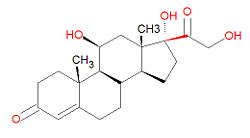Hydrocortisone: Difference between revisions
imported>Caesar Schinas m (Bot: Update image code) |
imported>Howard C. Berkowitz No edit summary |
||
| Line 2: | Line 2: | ||
{{Image|Hydrocortisone structure.jpg|right|250px|Hydrocortisone.}} | {{Image|Hydrocortisone structure.jpg|right|250px|Hydrocortisone.}} | ||
'''Hydrocortisone''' , a [[steroid]] hormone, is the most important human [[glucocorticoid]] and it is produced by the adrenal cortex. Synthetic versions are used in the treatment of [[inflammation]], [[allergy]], [[collagen]] diseases, [[asthma]], adrenocortical deficiency, [[endocrine]] (hormonal) disorders such as [[Addisons disease]], shock, and some [[neoplastic]] conditions. Topical hydrocortisone is used for its anti-inflammatory or immunosuppressive properties to treat inflammation due to corticosteroid-responsive dermatoses. Hydrocortisone binds to the [[cortisol receptor]], as do all glucocorticoids, to trigger metabolic, immunologic, cardiovascular and hoemostatic effects. It binds different receptors than do the sex steroids ([[androgen]]s and [[estrogen]]s) and the [[mineralocorticoid]]s. Glucocorticoids suppress cell-mediated immunity by inhibiting genes expression for many cytokines, including | '''Hydrocortisone''' , a [[steroid]] hormone, is the most important human [[glucocorticoid]] and it is produced by the adrenal cortex. Synthetic versions are used in the treatment of [[inflammation]], [[allergy]], [[collagen]] diseases, [[asthma]], adrenocortical deficiency, [[endocrine]] (hormonal) disorders such as [[Addisons disease]], shock, and some [[neoplastic]] conditions. Topical hydrocortisone is used for its anti-inflammatory or immunosuppressive properties to treat inflammation due to corticosteroid-responsive dermatoses. Hydrocortisone binds to the [[cortisol receptor]], as do all glucocorticoids, to trigger metabolic, immunologic, cardiovascular and hoemostatic effects. It binds different receptors than do the sex steroids ([[androgen]]s and [[estrogen]]s) and the [[mineralocorticoid]]s. Glucocorticoids suppress cell-mediated immunity by inhibiting genes expression for many cytokines, including [[interleukin]]s IL-1, IL-2, IL-3, IL-4, IL-5, IL-6, IL-8 and [[tumor necrosis factor-alpha]] (TNF-alpha), and by suppressing humoral immunity which caused lower amounts of IL-2 and IL-2 receptors to be expressed by B cells. This results in fewer T lymphocyte cells being activated. It is sold as over 100 different brand names. | ||
== Mechanism == | == Mechanism == | ||
Revision as of 08:28, 17 June 2009
Hydrocortisone , a steroid hormone, is the most important human glucocorticoid and it is produced by the adrenal cortex. Synthetic versions are used in the treatment of inflammation, allergy, collagen diseases, asthma, adrenocortical deficiency, endocrine (hormonal) disorders such as Addisons disease, shock, and some neoplastic conditions. Topical hydrocortisone is used for its anti-inflammatory or immunosuppressive properties to treat inflammation due to corticosteroid-responsive dermatoses. Hydrocortisone binds to the cortisol receptor, as do all glucocorticoids, to trigger metabolic, immunologic, cardiovascular and hoemostatic effects. It binds different receptors than do the sex steroids (androgens and estrogens) and the mineralocorticoids. Glucocorticoids suppress cell-mediated immunity by inhibiting genes expression for many cytokines, including interleukins IL-1, IL-2, IL-3, IL-4, IL-5, IL-6, IL-8 and tumor necrosis factor-alpha (TNF-alpha), and by suppressing humoral immunity which caused lower amounts of IL-2 and IL-2 receptors to be expressed by B cells. This results in fewer T lymphocyte cells being activated. It is sold as over 100 different brand names.
Mechanism
Hydrocortisone binds to the cytosolic glucocorticoid receptor. The receptor-ligand complex translocates into the cell nucleus and thne binds to glucocorticoid response elements (GRE) in the promoter region of the target genes. The DNA bound receptor then interacts with basic transcription factors, causing increased production of the target genes. Corticosteroids are thought to control inflammation by controlling the biosynthesis of prostaglandins and leuktrienes, the two main products of inflammation, through inhibition of achidonic acid. Specifically, glucocorticoids induce lipocortin-1 (annexin-1) synthesis, which then binds to cell membranes preventing the phospholipase A2 from binding its substrate, arachidonic acid, leading to diminished eicosanoid production. The cyclooxygenase (both COX-1 and COX-2) expression is also suppressed, potentiating the effect. The glucocorticoids stimulates lipcortin-1 to escape intor the extracellular space where it binds to leukocyte receptors to inhibit opithelial adhersion, emigration, enzymes, phagocytosis, respiratory burst and the release of inflammatory mediators such as as cytokines, chemokines and lysosomal enzymes, from neutrophils, macrophages and mastocytes.
Drug interactions
The effectiveness of hydrocortisone is diminished by many barbituates, including amobarbital, aprobartital, butabarbital, butalbital, butethal, dyhydroquinidine, heptabarbital, hexobartical, methohexital, methylphenobarbital, pentobarbital, phenobarbital, primidone, quinidine, secobarbital, talbutal. The effectiveness of hydrocortisone is also dimished by the enzyme inducers ethotoin, fosphenytoin, mephenytoin, phenytoin and rifampin and by cholestyramine and colestipol, two cholesterol lowering drugs.
Hydrocortisone decreases the effects of other drugs such as anticholinesterases, including ambenonium, edrophonium, neostigmine and pyridostigmine, salycylates, including aspirin, bismuth subsalicylate, salicylate-magnesium, salicylate-sodium T, salsalate and trisalicylate-choline. It also alters the anticoagulant effects of acenocoumarol, anisindione, dicoumarol and warfarin. The use of hydrocortisone with midodrine increases arterial pressure.
External Links
The most up-to-date information about Hydrocortisone and other drugs can be found at the following sites.
- Hydrocortisone - FDA approved drug information (drug label) from DailyMed (U.S. National Library of Medicine).
- Hydrocortisone - Drug information for consumers from MedlinePlus (U.S. National Library of Medicine).
- Hydrocortisone - Detailed information from DrugBank.
